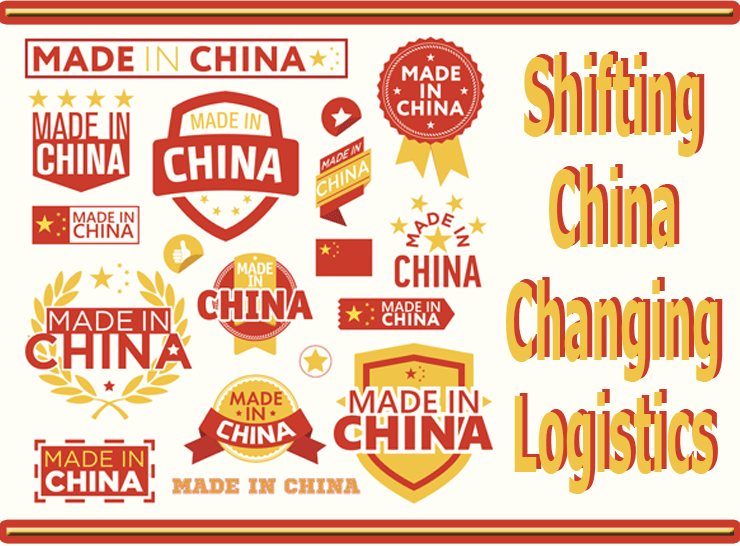Shifting China
Changing Logistics

One recent report from
HSBC offers great insight into the shift of manufacturing away from China’s
southern coastal regions. Authored by economist Jing Li, it details how,
after decades of coastal regions dominating China’s export-led economic
transformation, per capita incomes in coastal provinces are now double
those inland, while coastal wages and land costs are also often more expensive.
As this cost differential gives manufacturers
a hefty push away from the coast, government policy also increasingly
favors relocation.
Major investments in road, rail, and air
infrastructure are making interior locations more accessible, while subsidies
and tax breaks are often available as part of provincial development incentives
or under China’s “Go West” program, which is designed
to push economic sophistication westwards and reduce income differentials
between provinces.
HSBC identifies three key areas of economic
growth attracting new concentrations of manufacturing. In the north, Beijing’s
wealth is now being dispersed, which is benefitting the development of
Tianjin and Hebei.
New Silk
Road
From Shanghai, the Yangtze River is being
used to spread industrialization up to mid and upstream cities in the
regions of Jiangsu, Zhejiang, Anhui, Jiangxi, Hubei, Hunan, Sichuan, Chongqing,
Yunnan, and Guizhou. HSBC also draws attention to a “New Silk Road”
economic belt covering nine provinces, which, instead of viewing China’s
coast as its umbilical cord to world trade, is instead concentrated on
developing more direct links to Central Asia and onwards to Europe.
Since 2007, provinces in the western region
of the country have consistently recorded faster economic growth rates
than their eastern counterparts, according to Li, who said the trend was
also visible at company level.
“For decades, the coastal region of
China has led the export-dominated transformation of the country’s
industrial landscape,” he said. “However, economic forces
such as rising wages, land costs and recent improvements in transport
networks and other infrastructure are making a move inland increasingly
attractive for many companies, especially manufacturers. “Electronics
giant Foxconn, [which makes phones, games consoles and computers for the
world’s biggest brands, including Apple] which has moved production
away from Shenzhen in the prosperous Pearl River Delta, is a good example
of this trend.
“In 2010 Foxconn opened a USD $2 billion
plant in Chengdu, the capital of Sichuan, in western China. In the same
year it opened another plant in Zhengzhou, the capital of Henan province
in the central part of the country.”
As regular readers of FlyingTypers
will know, the provinces in the three growth areas identified by Li—not
least those near to Foxconn factories—are also home to fast-growing
freight airports.
Cargolux also recently established a new
hub at Zhengzhou, while UPS is offering flights out of Chengdu and Zhengzhou.
Moreover, a spate of major legacy carriers is now offering freighter and
passenger services from a wide variety of inland population and industrial
centers.
The Forwarder
Side
Dirk Noelle, senior vice-president Airfreight
North Asia Pacific, Kuehne & Nagel, said his company’s largest
operation in China is currently located in Shanghai, but growth opportunities
are increasingly located westwards.
“Offices in western China such as
Chengdu and Zhengzhou have rapidly developed as more and more manufacturing
shifts westwards,” he said. “Rising costs in coastal regions
in China have led to a shift in production inland.
“This has had a largely positive effect
in cities such as Chengdu and Zhengzhou, but of course a negative impact
in South China and Hong Kong, from where the production has moved away.”
Kuehne + Nagel now has a presence with a
full service portfolio of exports and imports in all major and most secondary
airports in China. The Switzerland-based forwarding giant also offers
industry specific solutions for the Aerospace (KN EngineChain), Pharmaceuticals
(KN PharmaChain), and Perishables (KN FreshChain) verticals.
“Next quarter we will extend our online
booking tool KN FreightNet to our Chinese customers,” said Noelle.
He said if China’s domestic airlines
started operating more long-haul services using wide-bodied aircraft linked
to inland networks, it could transform air freight logistics options in
China.
“The domestic network in China is
largely based on narrow body aircrafts, though of course exceptions exist,”
he explained. “Subsequently, the connectivity for large air cargo
shipments is limited. If these circumstances change, it would provide
a real advantage for inland airports.”
K&N plans to continue expanding its
China air freight footprint and Noelle expects that rising domestic demand
for imports will eventually offer more balanced trade for forwarders and
airlines.
“The ongoing shift of production-intensive
industries to Central and West China offers much potential for logistics
providers,” he said.
“In recent years we have also seen
a growing trend of air imports into China. This movement can be attributed
to the increasing economic development of the Chinese middle class.
“The growing imports, especially in
secondary markets, will certainly improve the balance.
“We will remain active in expanding
our network and we closely monitor manufacturing trends to be present
whenever opportunities arrive.”
Sky King
|





